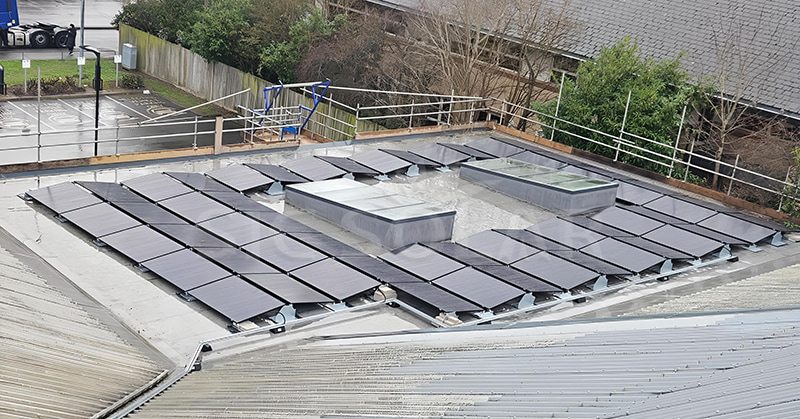Installing solar panels on a flat roof presents unique challenges and opportunities. Unlike pitched roofs, flat roofs do not naturally provide the ideal tilt angle for solar panels. However, with the right positioning and equipment, you can still achieve maximum energy efficiency. Here’s how to effectively position solar panels on a flat roof and optimize their performance.
1. Choose the Right Racking System
To ensure solar panels are positioned optimally on a flat roof, a racking system is essential. A tilt mounting system can elevate the panels, allowing them to capture sunlight more effectively. There are two main types of racking systems to consider:
- Fixed Tilt Racks – These racks are set at a specific angle, typically between 10 and 30 degrees, depending on your geographical location. This angle allows solar panels to capture the most sunlight throughout the year.
- Adjustable Racks – These systems allow you to adjust the tilt angle of the panels to adapt to seasonal changes in the sun’s position, providing more flexibility and higher energy production.
SIC Solar offers reliable and durable racking systems specifically designed for flat roof installations, ensuring stability and optimal tilt for maximum solar output.
2. Determine the Optimal Tilt Angle
The tilt angle is crucial for solar panels to maximize exposure to sunlight. The best angle varies depending on your location, but here are some general guidelines:
- Winter – To capture the lower-angle winter sun, tilt the panels at a steeper angle, typically between 25° and 40°.
- Summer – For the higher summer sun, tilt the panels at a shallower angle, generally between 10° and 20°.
For year-round performance, many systems use a moderate tilt angle around 20° to 30°, striking a balance between winter and summer performance.
3. Ensure Proper Spacing Between Panels
Proper spacing is essential to prevent shading and allow for easy maintenance. Shading from adjacent panels can significantly reduce the efficiency of your system, so ensure that:
- There is sufficient space between rows of panels to avoid shadows, particularly during the winter months when the sun is lower in the sky.
- Allow for adequate airflow around the panels to help reduce heat buildup and improve performance.
4. Consider Wind and Load Resistance
Flat roofs are often more exposed to strong winds, so it’s crucial to ensure the racking system is securely anchored. Some racking systems use ballasted mounting, which relies on the weight of concrete blocks to keep the panels in place without penetrating the roof surface. Ensure the system can withstand the local wind speeds and snow loads that might occur in your area.
SIC Solar’s high-quality mounting solutions are designed to withstand harsh environmental conditions, providing durability and long-term performance for flat roof solar installations.
5. Plan for Accessibility and Maintenance
To ensure that your solar panels remain efficient throughout their lifespan, plan for easy access for cleaning and maintenance. Allow enough space for technicians to reach the panels, clean them, and check for any damage or wear.
6. Check Local Regulations
Before proceeding with your solar installation, be sure to check with your local authorities regarding building codes and zoning regulations. In some areas, you may need a permit for solar panel installation, especially for commercial or large-scale installations.

For expert advice and high-quality flat roof solar mounting solutions, reach out to SIC Solar today!